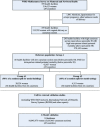A global reference for caesarean section rates (C-Model): a multicountry cross-sectional study
- PMID: 26259689
- PMCID: PMC4873961
- DOI: 10.1111/1471-0528.13509
A global reference for caesarean section rates (C-Model): a multicountry cross-sectional study
Abstract
Objective: To generate a global reference for caesarean section (CS) rates at health facilities.
Design: Cross-sectional study.
Setting: Health facilities from 43 countries.
Population/sample: Thirty eight thousand three hundred and twenty-four women giving birth from 22 countries for model building and 10,045,875 women giving birth from 43 countries for model testing.
Methods: We hypothesised that mathematical models could determine the relationship between clinical-obstetric characteristics and CS. These models generated probabilities of CS that could be compared with the observed CS rates. We devised a three-step approach to generate the global benchmark of CS rates at health facilities: creation of a multi-country reference population, building mathematical models, and testing these models.
Main outcome measures: Area under the ROC curves, diagnostic odds ratio, expected CS rate, observed CS rate.
Results: According to the different versions of the model, areas under the ROC curves suggested a good discriminatory capacity of C-Model, with summary estimates ranging from 0.832 to 0.844. The C-Model was able to generate expected CS rates adjusted for the case-mix of the obstetric population. We have also prepared an e-calculator to facilitate use of C-Model (www.who.int/reproductivehealth/publications/maternal_perinatal_health/c-model/en/).
Conclusions: This article describes the development of a global reference for CS rates. Based on maternal characteristics, this tool was able to generate an individualised expected CS rate for health facilities or groups of health facilities. With C-Model, obstetric teams, health system managers, health facilities, health insurance companies, and governments can produce a customised reference CS rate for assessing use (and overuse) of CS.
Tweetable abstract: The C-Model provides a customized benchmark for caesarean section rates in health facilities and systems.
Keywords: Benchmarking; caesarean delivery rates; caesarean section rates; logistic regression.
© 2015 World Health Organization; licensed by John Wiley & Sons Ltd on behalf of Royal College of Obstetricians and Gynaecologists.
Figures
Comment in
-
A global reference for CS at health facilities? Yes, but there is work to do.BJOG. 2016 Feb;123(3):437. doi: 10.1111/1471-0528.13619. Epub 2015 Sep 28. BJOG. 2016. PMID: 26412795 No abstract available.
References
-
- Shearer E. Cesarean section: medical benefits and costs. Soc Sci Med 1993;37:1223–31. - PubMed
-
- Souza JP, Gülmezoglu AM, Lumbiganon P, Laopaiboon M, Carroli G, Fawole B, et al. Caesarean section without medical indications is associated with an increased risk of adverse short‐term maternal outcomes: the 2004–2008 WHO Global Survey on Maternal and Perinatal Health. BMC Med 2010;8:1–10. - PMC - PubMed
-
- Betrán AP, Merialdi M, Lauer JA, Bing‐Shun W, Thomas J, Van Look P, et al. Rates of caesarean section: analysis of global, regional and national estimates. Paediatr Perinat Epidemiol 2007;21:98–113. - PubMed
-
- Zizza A, Tinelli A, Malvasi A, Barbone E, Stark M, De Donno A, et al. Caesarean section in the world: a new ecological approach. J Prev Med Hyg 2011;52:161–73. - PubMed
Publication types
MeSH terms
Grants and funding
LinkOut - more resources
Full Text Sources
Other Literature Sources
Medical
Research Materials


